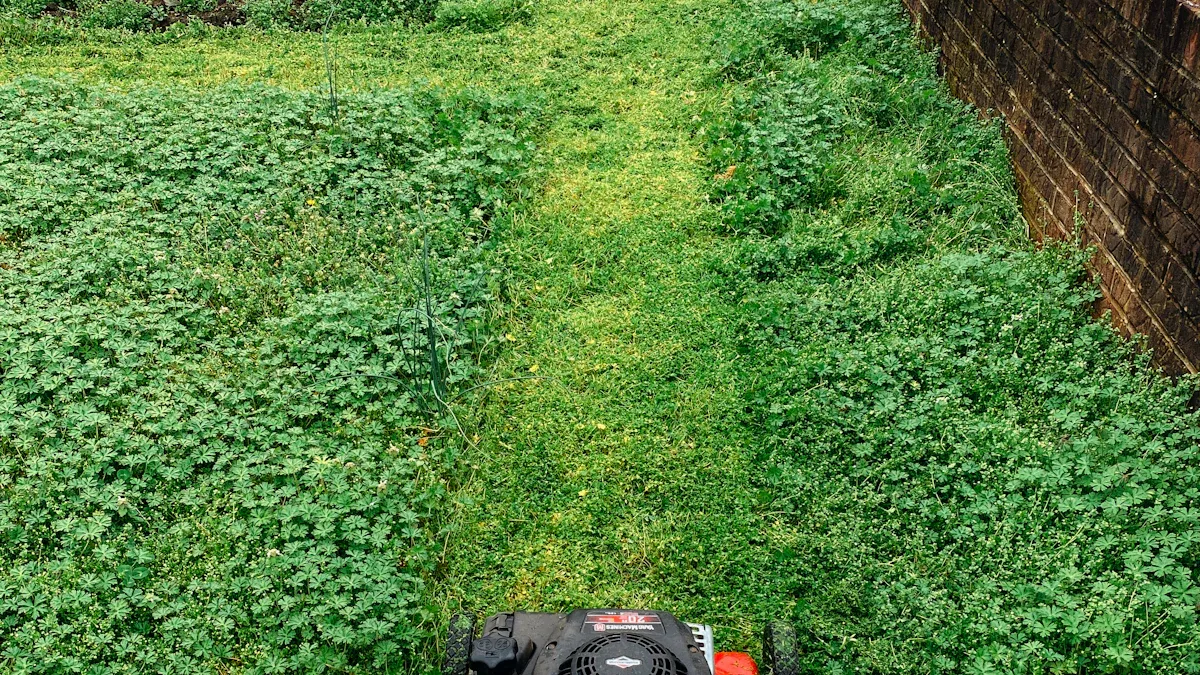
Choosing the correct tool for your lawn care needs saves you time, effort, and money. The global lawn mower market reached USD 16.65 Billion in 2024. This comprehensive lawn mowers guide helps you select the right equipment. You will explore various types of lawn mowers, including walk-behind, ride-on, and robotic mowers. We will focus on three main lawn mower types: reel mowers, rotary mowers, and robotic mowers. Each offers distinct advantages for your yard.
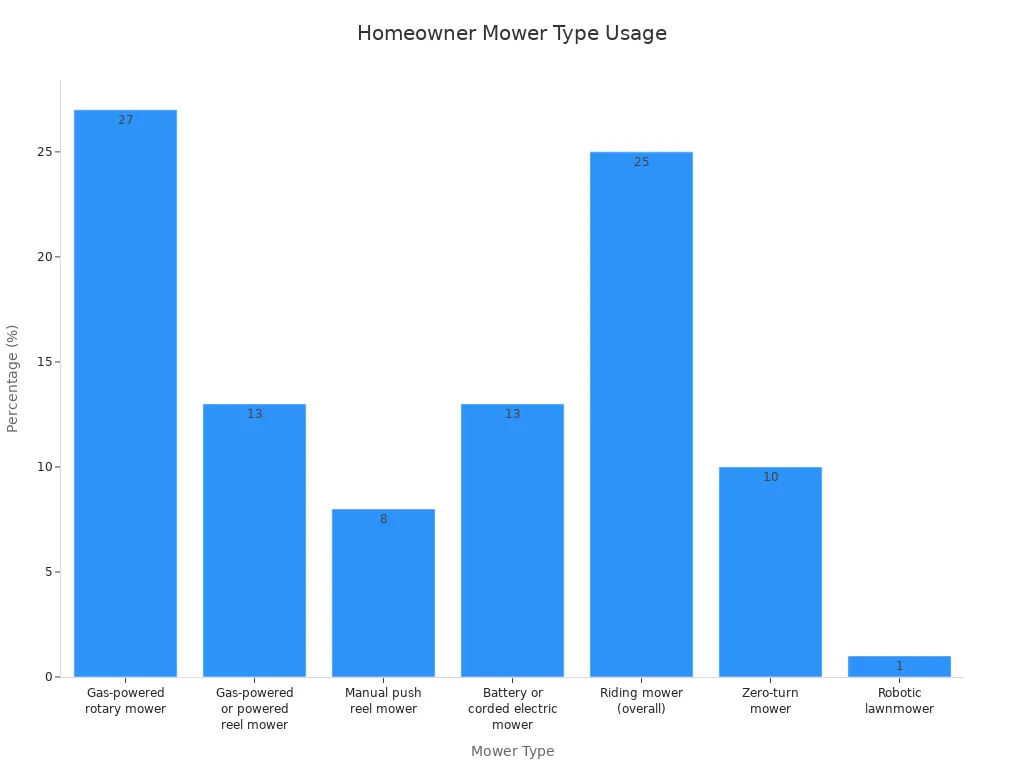
These different types of mowers offer unique benefits. This guide will demystify their differences.
Key Takeaways
Reel mowers cut grass like scissors. They give a very clean cut. They are best for small, flat lawns and specific grass types.
Rotary mowers use a fast-spinning blade. They cut grass by hitting it. They work well for most lawns, especially taller or thicker grass.
Robotic mowers cut your lawn by themselves. They save you time. They are quiet and good for the environment. They are best for small to medium-sized lawns.
Consider your lawn size, how much money you want to spend, and how much work you want to do. This helps you pick the best mower for your yard.
Regular care keeps your mower working well. Clean it often. Sharpen blades when needed. This makes your mower last longer.
Reel Mowers
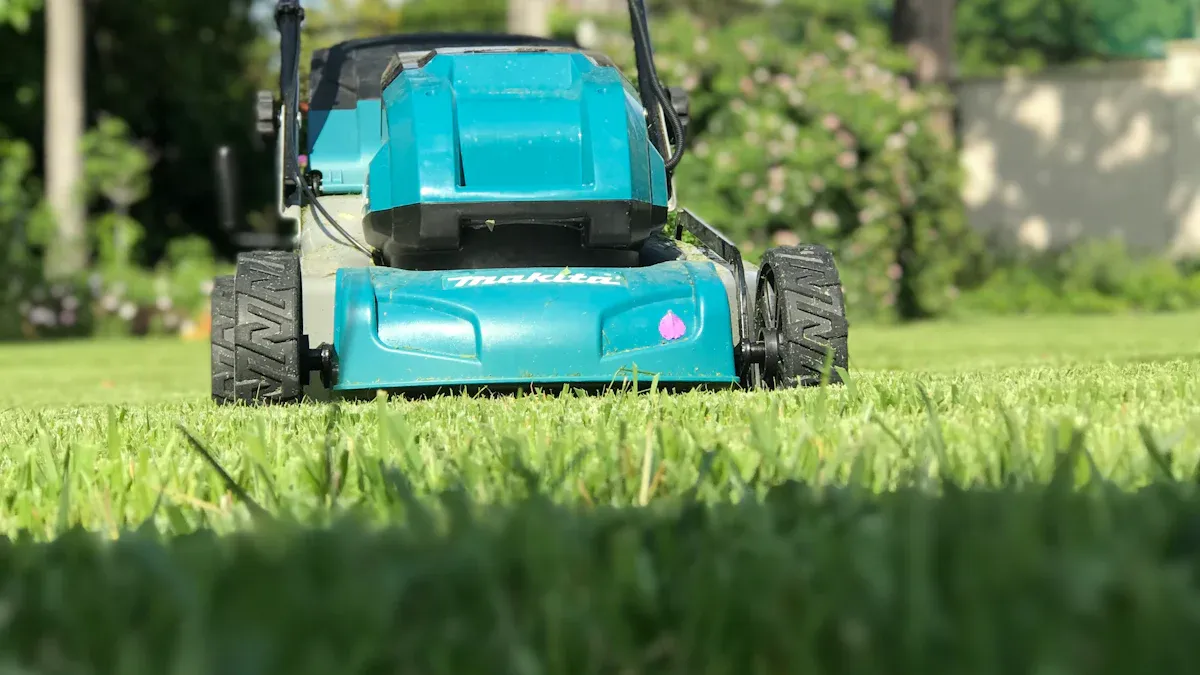
How Reel Mowers Work
Reel mowers are a traditional type of lawn mower. Many people know them as push mowers. They use a unique horizontal slicing action. This action involves multiple blades and a cutting bar. The spinning reel itself does not cut the grass directly. Instead, the cutting happens where the spinning edges of the reel meet a stationary cutter bar. This bar is at the rear of the mower. The reel’s cylinder scoops up the grass. It guides the grass towards this cutter bar. This process is similar to how a barber uses a comb to position hair for cutting. This scissor-like mechanism provides a very clean cut.
Reel Mower Advantages
Reel mowers offer several benefits for your lawn’s health.
Clean Cut vs. Shredding: Reel mowers use a scissor-like action. They lift and cut individual grass blades cleanly. This prevents the ‘white-tip’ condition. This condition makes grass tips turn white or brown. Rotary mowers often cause this by chopping or tearing, especially with dull blades. A clean cut means a healthier and better-looking lawn for you.
Natural Fertilization: Reel mowers let grass clippings fall back onto the soil. These clippings act as a natural fertilizer. They return nitrogen to your lawn. This helps enrich the soil and improves overall lawn health.
Environmental Impact: These mowers are often human-powered. They do not produce air pollution from fossil fuels. This indirectly benefits your lawn’s environment. They also need less frequent blade sharpening than rotary mowers. This reduces maintenance and resource use. Reel mowers are also much quieter than other types.
Reel Mower Disadvantages
While reel mowers offer many benefits, they also have some limitations.
Manual Effort: Pushing a reel mower on uneven surfaces requires physical effort. This can lead to inconsistent blade-to-ground contact. The result is an uneven cut.
Height Adjustments: Adjusting the cutting height on uneven ground can be difficult. Reel mowers have fewer adjustable features compared to other mower types.
Obstacles: Rocks, roots, and dips can block the mower’s path. These obstacles can damage the blades. This increases maintenance costs for you.
Grass Conditions: Reel mowers work best when the grass is not too long. They are also less effective on wet or undulating lawns. You might struggle if your grass is overgrown or damp.
Ideal Use for Reel Mowers
Reel mowers are perfect for specific lawn types and conditions. They excel at maintaining lower mowing heights, often under an inch. If you have a small, flat lawn, a reel mower is an excellent choice. They are also ideal for certain grass species.
Annual ryegrass
Bermudagrass (seeded and hybrids)
Colonial bentgrass
Creeping bentgrass
Dichondra
Hard fescue
Kentucky bluegrass
Kikuyugrass
Perennial ryegrass
Red fescue
Rough bluegrass
Seashore paspalum
Tall fescue
Zoysiagrass
If your lawn features these grasses and you prefer a very short, manicured look, a reel mower will give you excellent results.
Rotary Mowers
Rotary mowers are a common type of lawn mower. They use a different cutting method than reel mowers. You will find them suitable for many types of lawns.
Rotary Mower Mechanics
A rotary mower works with a single blade. This blade spins very fast around a vertical axis. The spinning blade cuts the grass by impact. Think of it like a propeller. This action is effective for cutting medium to long grass. The blade’s speed is important for a clean cut. The RPM of a rotary mower blade does not directly relate to its tip speed. Blade lengths vary. Tip speed is usually measured in feet per minute (fpm). Some users operate their mowers at 3300 RPM. They suggest higher engine speed helps cut thick turf. One user increased their 21-inch mower from 2600 RPM to 3500 RPM. They noted improved cutting.
Gas Rotary Mowers
Gas-powered rotary mowers use an internal combustion engine. This engine powers the spinning blade. You often find these mowers on larger lawns. They offer strong power and do not need an electrical cord. An ExMark Lazer S zero-turn mower shows their fuel use. This model has a 60-inch deck and a 27hp Kawasaki gas engine. It uses about 1.5 gallons of fuel per hour. This happens when it operates at wide-open throttle and mowing speed. These gas-powered rotary mowers are powerful tools for your yard work.
Electric Corded Rotary Mowers
Electric corded rotary mowers get their power from an outlet. You plug them into a standard electrical socket. These mowers are quieter than gas models. They produce no emissions. Most electric mowers in North America use 120V household current. They typically feature 13A motors. This limits them to about 1,560 Watts of power. In the UK, 230V electric mowers usually have a power output between 1200 and 1600W. This is similar to their 120V counterparts.
Battery Rotary Mowers
Battery rotary mowers run on rechargeable batteries. They offer the convenience of corded electric mowers without the cord. You get freedom of movement. These mowers are also quieter and produce no emissions. Battery life varies by voltage platform.
Voltage Platform | Typical Runtime (minutes) |
|---|---|
80V | Up to 60 |
60V | 45-50 |
40V | 30-40 |
Most Canadian yards can be finished on a single charge. You need an appropriately powerful battery mower. Weekly mowing sessions often last between 20 and 30 minutes.
Rotary Mower Advantages
Rotary mowers offer many benefits. They are very versatile.
Handles Tough Conditions: Rotary mowers have heavy, high-powered blades. Their thick blades cut through saplings and dense vegetation easily. They clear overgrown brush, grass, and trees effectively.
Cuts Taller Grass: These mowers handle taller and thicker grass more easily. They are not designed to mulch it as finely as finish mowers.
Robust Design: They are more robust. They handle obstacles like rocks and sticks better. Rotary cutters are more forgiving of occasional rocks. This is true compared to mowers with traditional fixed blades.
Traction: They maintain traction in wet and hilly conditions. This is due to all-wheel drive CrossTrax® systems and turf-friendly tires. They power through thick grass. They still provide a clean, finely manicured finish.
Rotary Mower Disadvantages
Rotary mowers also have some drawbacks.
Noise Levels: Gas-powered rotary mowers can be quite loud. They typically produce noise levels from 85 to 100 dB. The average decibel level for a gas-powered lawn mower is 90 dB. This can be disruptive.
Less Precise Cut: The impact cutting action can sometimes tear grass blades. This is especially true if the blade is dull. This can lead to a less healthy look for your lawn.
Maintenance: Gas models require fuel, oil changes, and spark plug maintenance. Electric models need battery charging or cord management.
Ideal Use for Rotary Mowers
Rotary mowers are great for many different lawn types. They are effective on ‘semi-rough’ mowing. This includes former hayfields. You can use them on various lawn sizes. The Toro Groundsmaster line offers cutting widths from 60 inches (152 cm) to 192 inches (488 cm). These mowers can achieve productivity rates of up to 20.9 acres per hour. This makes them suitable for small to large areas. They even work well for wide open public spaces. Rotary cutters do a very nice job mowing grass. You just need to keep your ground speed reasonable.
Robotic Mowers
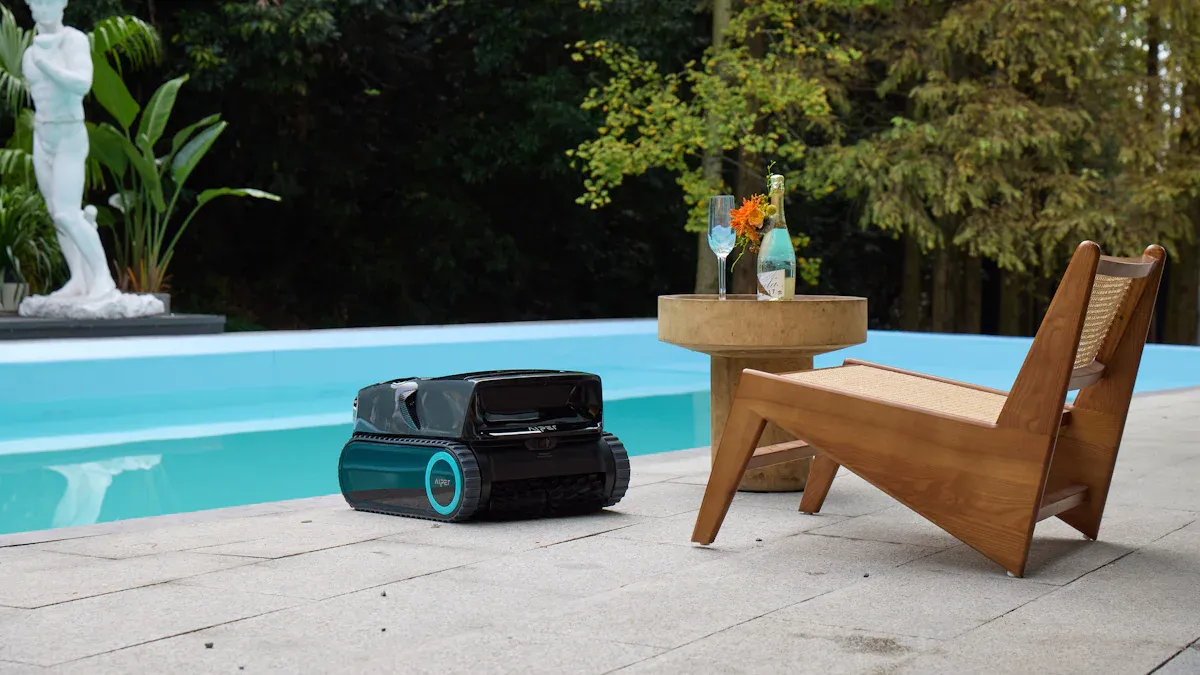
Robotic mowers offer a modern solution for lawn care. These advanced machines handle mowing tasks for you. They provide a convenient way to maintain your yard.
How Robotic Mowers Operate
Robotic mowers work autonomously. They navigate your lawn without direct human control. These devices, sometimes called “Automowers,” use sophisticated technology. For example, they use RTK GPS navigation technology and georeferencing alerts. Some models use Visual SLAM for 3D mapping and positioning. Others combine integrated GPS with a camera system. This allows them to understand their surroundings and cut your grass efficiently.
Robotic Mower Features
These mowers come with many features. Safety is a key aspect. Autonomous Mowing Robots™ include a complete Safety Interlock System. They use LiDAR technology for 360-degree object detection. This stops them automatically for people, animals, or vehicles. You will also find on-machine emergency stop buttons and a Remote Stop handheld unit. Geofencing controls boundaries. Operator authentication requirements add security. Remote-controlled mowers also feature anti-tilt-and-drop sensors. These shut down the machine if you do not hold the controller safely.
Robotic Mower Advantages
Robotic mowers offer significant benefits. They save you time. Homeowners with a half-acre lawn save about 60 hours per year. This means you save over an hour each week. These electric mowers are also good for the environment. They produce zero direct emissions. Their carbon footprint is much lower than gas mowers. They operate quietly, usually under 60 dB. This is like a normal conversation. These rechargeable lawn mowers also mulch grass clippings. This returns nutrients to your soil.
Robotic Mower Disadvantages
Robotic mowers also have some drawbacks. The initial cost can be high. Models can range from about $1,900 to nearly $14,000. Commercial units can cost over $33,000. They also have limitations on lawn size. Some robot lawn mowers, like the LawnMaster OcuMow™ R1600, cover up to 1,600 square feet. This makes them best for smaller yards.
Ideal Use for Robotic Mowers
Robotic mowers are ideal for people seeking hands-free lawn care. They suit small to medium-sized lawns. If you want consistent mowing and enjoy smart home technology, these are a great choice. They work well for those who prefer quiet operation and an eco-friendly option.
Comparing Lawn Mower Types
You need to choose the right mower for your lawn. This section helps you understand which of these lawn mower types best suits your needs. We will compare the different types based on several factors.
Lawn Size & Terrain
Your lawn’s size and terrain greatly influence your mower choice. Different types of lawn mowers excel in various environments.
Lawn Size Category | Area (sq ft) | Recommended Mower Types |
|---|---|---|
Small Yards | Under 8,000 | Manual reel mowers (for fine grass, exercise, environmental priority), Battery-powered push mowers, Gas push mowers |
Medium Yards | 8,000 – 20,000 | Self-propelled mowers (rear-wheel drive for versatility), Battery technology (higher voltage systems), Gas self-propelled mowers |
Large Yards | Over 20,000 | Riding mowers (lawn tractors for straightforward mowing, zero-turn for obstacles), Commercial walk-behind mowers |
For example, a 20-inch reel mower works well for a 5400 square feet lawn. A larger 26-inch reel mower might not save you much time on a similar size lawn. Robotic mowers work best on relatively flat yards. They handle frequent, small cuts well. They also manage grass height effectively.
Budget & Maintenance
Consider your budget and maintenance needs. Each of the lawn mower types has different costs.
Lawn Mower Type | Annual Maintenance Cost |
|---|---|
Reel Mower | $10 to $50 |
Gas Push Mower | $25 to $70 |
Self-Propelled Mower | $30 to $97 |
Riding Mower | $92 to $223 |
You also need to consider tune-up costs.
Mower Type | Average Tune-Up Cost |
|---|---|
Push Mower | $110 |
Self-Propelled Mower | $150 |
Lawn Tractor | $240 |
Zero-Turn Mower | $285 |
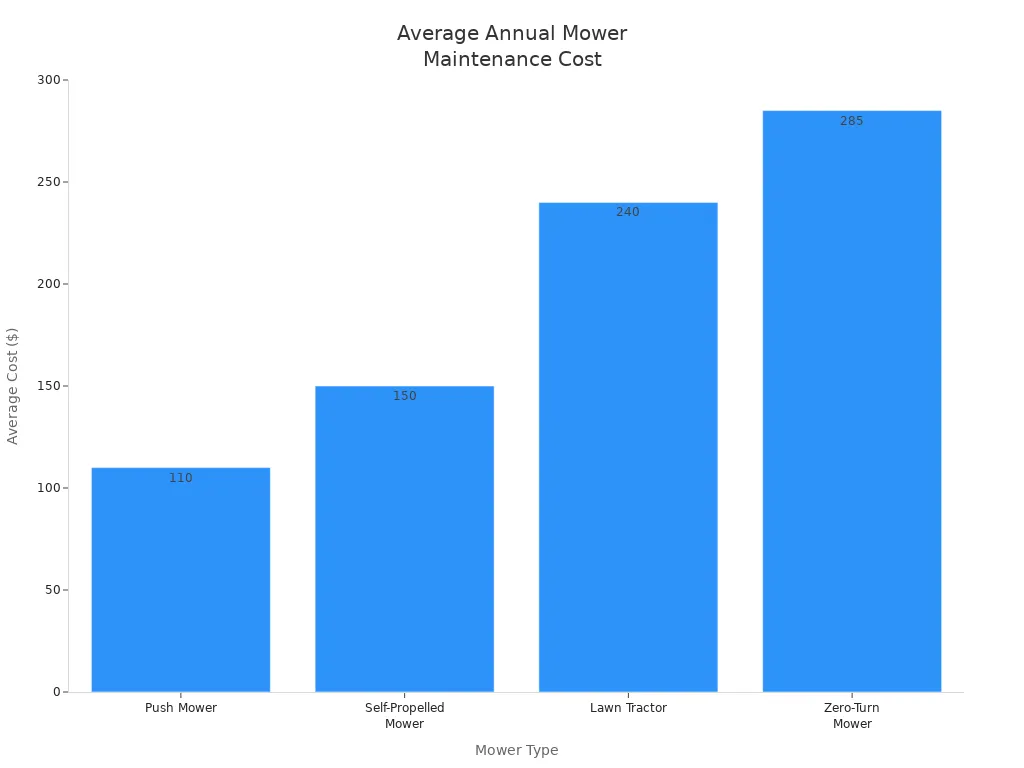
Robotic mowers have a higher initial cost. Models can range from about $1,900 to nearly $14,000. Commercial units can exceed $33,000.
Environmental Impact & Noise
Your choice of mower impacts the environment and noise levels. Gas mowers produce more emissions.
Mower Type | Annual CO2 Emissions (grams) | CO2 Emissions per Acre (relative to electric) |
|---|---|---|
Gas | 24,075 | 16 times more |
Electric | 21,240 (zero with renewable energy) | 1 (baseline) |
Operating a gas-powered mower for one hour creates emissions. These emissions equal driving a car for 100 miles. Gas mowers also release carbon monoxide, nitrogen oxides, and volatile organic compounds. These contribute up to 5% of the nation’s air pollution. Electric and robotic mowers produce zero direct emissions. They operate much more quietly. Gas mowers typically produce 85 to 100 dB. Robotic mowers usually stay under 60 dB.
Personal Preferences
Your personal preferences also guide your choice of lawn mowers. Consumer Reports evaluates mowers. They use test performance data, predicted reliability, and owner satisfaction ratings. These ratings come from member surveys. Surveys from 2022 to 2024 collected data on over 46,000 mowers. Testing involves cutting 500,000 square feet of grass. They assess handling on various terrains. They also review convenience features.
Consider these factors:
Gas Lawn Mowers:
Pros: They handle long, thick grass and weeds. They can bag, side-discharge, or mulch clippings. They generally cost less upfront. They run longer than battery-powered models.
Cons: They are noisy, so you need ear protection. They produce emissions. They require more frequent maintenance.
Upkeep: You need regular tune-ups, oil changes, and blade sharpening.
Robotic Mowers:
Upkeep: You need to clean the underside regularly. Replace blades once or twice a season. Periodically check wiring and the charging station.
Walk-Behind Mowers (Features influencing satisfaction):
Push vs. self-propelled: Self-propelled models are easier to maneuver on large or sloped lawns.
Drive type: All-wheel drive offers the best traction on slopes. Rear-wheel drive is next. Front-wheel drive works well for flat surfaces.
Blade-brake clutch pedal: This lets you stop blades without restarting the engine.
Washout port: This simplifies cleaning the mower’s underside.
Electric start: This provides push-button starting ease for gas models. It is standard on electric mowers.
One-lever height adjustment: This simplifies adjusting the entire mowing deck.
Folding handle: This reduces storage space.
Upright storage: This is available on almost all electrics and some gas models.
Interchangeable battery: This lets you use the same battery across multiple tools. This saves you money.
Riding Mowers (Features influencing satisfaction):
Hour meter: This helps you track maintenance schedules.
Fuel meter: This allows easy monitoring of fuel levels.
Cruise control: This locks in a consistent speed.
Hydrostatic transmission: This enables smooth and quick ground speed changes.
Electric power takeoff switch: This conveniently engages blades and extends belt life.
Safety switch for reverse: This requires intentional action to mow in reverse. This enhances safety.
Tight turning: Four-wheel steering and newer two-wheel-steering models offer better maneuverability.
High-back seat and cup holder: These enhance your comfort during operation.
This lawn mowers guide helps you understand the various types. You can now make an informed decision.
Maintenance for Your Lawn Mowers Guide
Proper maintenance keeps your mower running well. This lawn mowers guide helps you care for each type. Regular care extends your equipment’s life. It also ensures a healthy, beautiful lawn.
Reel Mower Care
You should clean your reel mower after each use. Remove grass clippings from the blades and cutting bar. This prevents rust and keeps the mechanism clear. Sharpening the blades is also important for a clean cut. The frequency depends on your mower type:
Mower Type/Brand | Recommended Sharpening Frequency |
|---|---|
Contact-free mowers (Brill, Easuns, Sunlawns) | Do not require sharpening; adjust gap as needed |
Contact mowers (Scotts, American, Great States, most others) | Every 1-2 years (spring is best) |
Brill Reel Mowers | Every 5-8 years |
Easun Naturcut Reel Mowers | Every 7-10 years |
Fiskars Momentum Reel Mower | Long Lasting |
Great States Reel Mowers | Every year |
Scotts Classic Reel Mower | Every year |
Easun Silent Cut Mowers | Every 2 years |
Rotary Mower Care
You must maintain your rotary mower regularly. This includes both gas and electric models. For gas rotary mowers, seasonal engine maintenance is crucial.
Oil Change Procedure: Follow manufacturer instructions. Drain old oil, replace the oil filter, and refill with fresh oil. This ensures proper lubrication.
Spark Plug Inspection and Replacement: Check for wear or carbon buildup. Replace the plug if necessary. This prevents starting issues and ensures reliable ignition.
Fuel System Management: Use fresh fuel and correct additives. This prevents gumming and deposits. Regularly clean the fuel system. Remove old fuel, clean the tank, and inspect fuel lines for blockages. This ensures consistent performance.
Winter Storage Preparation: Thoroughly clean your mower. Drain the fuel system. Store it in a dry, protected area. This prevents rust and deterioration.
Spring Start-up Procedures: Before the mowing season, inspect all components. Check and replace the oil. Install a new air filter. This prepares your mower for optimal performance.
For electric mowers, keep the deck clean and check the blade for sharpness.
Robotic Mower Care
Robotic mowers need specific care. You should clean the underside regularly. Replace blades once or twice a season. Periodically check wiring and the charging station. Battery care is also vital for these advanced machines.
Adhere to the manufacturer’s guidelines for charging and storage.
Avoid exposing your mower to extreme temperatures.
Maintain clean and debris-free contacts and connectors.
Prevent frequent complete battery discharge.
Charge batteries regularly. Avoid complete discharge (recharge around 20% power remaining) and overcharging. Use battery maintainers for winter storage.
Keep battery terminals clean and dry. Check monthly for corrosion and ensure proper connections. Sharp blades also reduce battery strain.
Maintain a regular usage pattern. Frequent use on large or rough terrains can strain the battery and reduce its lifespan.
Store under proper conditions. Avoid extreme temperatures. Ideal storage is between -20 to 25°C with the battery at about 50% charge for long-term storage.
This lawn mowers guide explored various types of lawn mowers. You learned about reel, rotary, and robotic options. Each offers unique benefits for your yard. The best choice depends on your specific needs. Consider your lawn size, terrain, budget, and desired effort. Weigh the pros and cons of these mower types. You can then select the perfect equipment. Enjoy your perfectly manicured lawn.
FAQ
What is the main difference between a reel mower and a rotary mower?
A reel mower cuts grass with a scissor-like action. Its blades meet a stationary bar for a clean cut. A rotary mower uses a single blade that spins fast. This blade cuts grass by impact. You get a precise cut with a reel mower. A rotary mower handles taller grass better.
What makes robotic mowers a good choice for some lawns?
Robotic mowers offer hands-free lawn care. They operate by themselves, saving you time. These mowers are quiet and produce no emissions. They also mulch grass clippings, returning nutrients to your soil. You get a consistently neat lawn with minimal effort.
What type of mower is best for a small, flat lawn?
For a small, flat lawn, a reel mower is often ideal. It provides a very clean cut and is environmentally friendly. You can also choose a battery-powered rotary mower. These are quiet and easy to maneuver. They work well for smaller spaces.
What are the environmental benefits of electric lawn mowers?
Electric lawn mowers produce zero direct emissions. This means they do not pollute the air like gas mowers. They also operate much more quietly. You reduce your carbon footprint when you choose an electric or robotic mower. This helps create a healthier environment.


